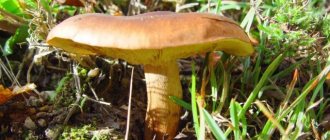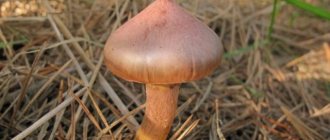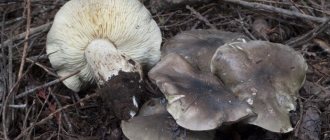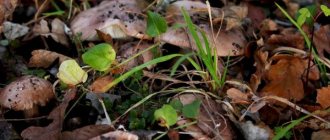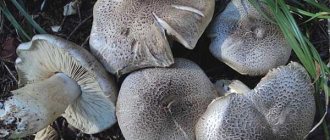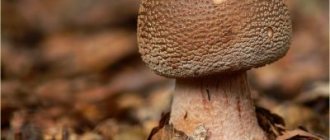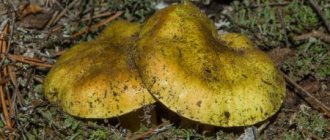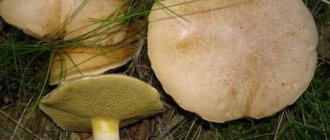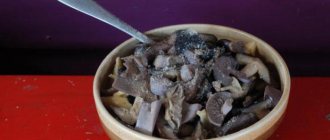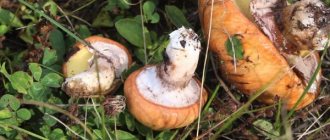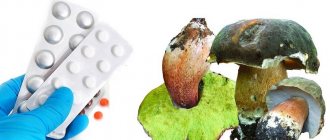Related species
What kind of mushrooms are honey mushrooms?
Honey mushrooms are a group of mushrooms that includes a fairly large number of species belonging to different genera and even families. What they have in common is that most of them grow on living or dead wood.
Honey mushrooms are quite prolific and usually form large families and clusters, which allows the mushroom picker to quickly fill his baskets with mushroom trophies.
Types of mushrooms
Beginning mushroom pickers often ask the question: what kinds of mushrooms are there? The yellow-red honey fungus has many relatives. First of all, you should pay attention that there is a genus of honey fungus (Armillaria), which includes:
- autumn honey fungus – Armillaria mellea;
- thick-legged honey fungus – Armillaria gallica;
- bulbous honey fungus – Armillaria bulbosa;
- dark honey fungus – Armillaria ostoyae, etc.
Honey mushrooms also include some species from the genus Marasmius:
- meadow honey fungus (meadow honey fungus) – Marasmius oreades;
- garlic honey fungus (common spadefoot) – Marasmius scorodonius;
- cheese honey fungus – Marasmius bulliardii;
- sinewy-plate honey fungus (leaf rotting mushroom) – Marasmius epiphyllus, etc.
Honey mushrooms belonging to other genera and families:
- summer honey fungus (Kuehneromyces mutabilis) – Kuehneromyces mutabilis – genus Kuehneromyces (Kuehneromyces), family Strophariaceae;
- winter honey fungus (Flammulina velutipes) – Flammulina velutipes – genus of Flammulina, family Physalacriaceae;
- mucous honey fungus (Udemansiella mucosa) – Oudemansiélla múcida – genus Oudemansiella, family Physalacriaceae, etc.
What can cause a fever without increasing body temperature
Environment or lifestyle
Many lifestyle and environmental factors can cause a person to develop a fever, but there will be no fever. Factors include:
High air temperature
Hot or humid weather is hard on the body and can affect some people. In hot weather, a person may feel irritable, tired, or have difficulty concentrating. In some cases, extreme temperatures or prolonged sun exposure can cause sunburn, heatstroke, or sunstroke.
A sunburn occurs when the sun damages the skin, causing the skin to feel hot and sore. Heatstroke occurs when a person loses too much fluid and salt through sweating. Symptoms of heat stroke include:
- heavy sweating
- cold, clammy skin
- nausea or vomiting
- weakness
- headache
- dizziness
- muscle weakness or cramps
A person with heatstroke should cool down, drink fluids, and stop exercising. If a person does not get better within 1 hour, they should seek medical help immediately.
Exercise or strenuous activity
Exercise or physical work can increase a person's body temperature, especially if they:
- not used to exercising regularly
- exercise or perform physical activity in a hot or humid environment
- overexert themselves
Athletes who train in hot weather should monitor their well-being and stop training if they feel weak or faint.
Avoiding exercise during the hottest part of the day and drinking more water will help avoid fever during exercise.
Food and drink
Some foods and drinks can cause a fever. These include:
- alcohol
- caffeinated drinks
- spicy food
- hot food and drinks
People may feel warmth on their skin or sweat more than usual during and after consuming these products.
Cloth
Tight, tight or dark clothing can increase body temperature and prevent air from circulating around the skin. Synthetic fibers can also trap heat and prevent sweat from evaporating. This can cause excessive heat production and increased sweating.
Similar species and false look-alikes
During a quiet hunt, the ability to recognize each individual type of mushroom and distinguish it from similar edible species is of great importance. But the most important thing is to learn to distinguish it from inedible and poisonous mushrooms that are similar in appearance, which can harm not only health, but sometimes even human life.
Fortunately, there are no uniquely poisonous counterparts with which the yellow-red honey fungus can be confused. The mushroom has the greatest external similarity with two species that have a controversial reputation: due to the bitter taste of the pulp, some authors classify them as inedible. Others consider them conditionally edible, which can be eaten after additional preliminary pre-culinary processing.
How to distinguish yellow-red honey fungus?
Tricholomopsis beautiful
Beautiful tricholomopsis or olive-yellow row (Tricholomopsis decora) fully lives up to its name: the mushroom stands out for its exceptional external characteristics. It is a related species of the yellow-red honey fungus and also belongs to the genus Tricholoma of the family Tricholomataceae. Conditionally edible.
The distinctive features of the olive-yellow row are:
- A noticeable depression that is often located in the center of the cap.
- The color of the cap is yellow, in the central part it is yellow-brown, but lighter than that of the yellow-red honey mushroom.
- The scales on the cap, although present, are darker in color than the caps, but in the yellow-red honey fungus they are of a different color - purple, reddish-brown, burgundy-violet.
- The size of the mushroom is noticeably smaller.
- Taste: bitter, rancid.
- Although it also settles on coniferous trees, it is much less common.
Reference! Before the main culinary processing, the olive-yellow row should be boiled for 15 minutes. The broth is drained and not consumed.
Brick-red false honey fungus
Brick red honey fungus (Hypholoma lateritium) is a representative of false honey mushrooms. Belongs to the Hypholoma genus of the Strophariaceae family. Conditionally edible.
Brick-red false honey fungus has the following distinctive features:
- There are no scales on the cap.
- Along the edge of the cap, whitish or yellowish flakes are clearly visible - the remains of a private bedspread.
- The color of the plates at a young age is light grayish, cream, yellowish-gray, then darkens and becomes gray, olive-gray, often with a violet tint.
- In contrast to the yellow-red honey fungus, it mainly settles on deciduous trees, including fruit trees, but can also be found on conifers.
- It grows in large clustered colonies in which the mushrooms are connected by the base of the stalks.
Reference! Pre-treatment of brick-red false foam consists of boiling it in salted water for thirty minutes. Then the broth is drained, and the mushrooms are washed two or three times in a large volume of water, which is changed each time, while carefully squeezing out the caps.
Contraindications for use
Only young mushrooms are suitable for consumption.
Despite its usefulness, not everyone is allowed to eat this mushroom variety. Main contraindications:
- children under 7 years of age;
- period of pregnancy and breastfeeding;
- diseases of the stomach and intestines in the acute phase;
- renal and liver failure;
- low acidity;
- pancreatitis and cholecystitis.
It is not safe to eat old red mushrooms. It is prohibited to collect fruiting bodies near industrial enterprises, highways, and garbage dumps: the mycelium quickly absorbs toxins.
Rows collected in violation of the rules can provoke poisoning. The main symptoms are nausea, vomiting, diarrhea, abdominal pain, headache. The condition is treated by cleansing the stomach, taking sorbents and probiotics as prescribed by a doctor.
Botanical description
hat
The cap of the yellow-red honey mushroom is round and fleshy. Initially convex, as it grows it becomes prostrate.
The skin of the yellow-red honey fungus is dry, velvety, matte. The color of young mushrooms is purple-purple, then changes to reddish-yellow in mature specimens, often with a purple tint. Densely covered with small fibrous purple, reddish-brown, burgundy-violet scales.
Diameter: 5-10, up to 15 cm.
Hymenophore
The hymenophore of the honey agaric is yellow-red (the lower part of the cap) - the plates are wide, sinuous, frequent, spiny along the edge, notched-adherent. Color: yellowish, bright yellow.
The spores of the yellow-red honey fungus are broadly elliptical, almost round. Size: 6.5 x 5 microns. Color of yellow-red honey fungus spore powder: white.
Leg
The leg is round, dense, smooth or curved, thickened towards the base. Hollow, in young mushrooms it can be solid. The color is the same as the cap - yellow-red. Just like the cap, it is covered with small purple or lighter scales.
Leg length of yellow-red honey fungus: 4-7, up to 12 cm, diameter: 0.5-3 cm.
Pulp
The flesh of the cap is thick, dense, elastic, the legs are fibrous. Color: yellow, bright yellow. The taste is weak; older specimens may have bitterness. Odor: sour, reminiscent of rotting wood.
Definitioner
Basidia (Basidia)
Lat. Basidia. A specialized structure of sexual reproduction in fungi, unique to basidiomycetes. Basidia are terminal (end) elements of hyphae of various shapes and sizes, on which spores develop exogenously (outside).
Basidia vary in structure and method of attachment to hyphae.
Based on the position relative to the axis of the hyphae to which they are attached, three types of basidia are distinguished:
Apical basidia are formed from the terminal cell of the hypha and are located parallel to its axis.
Pleurobasidia are formed from lateral processes and are located perpendicular to the axis of the hypha, which continues to grow and can form new processes with basidia.
Subbasidia are formed from a lateral process turned perpendicular to the hyphal axis, which stops growing after the formation of one basidium.
Based on morphology:
Holobasidia are single-celled basidia, not divided by septa (see Fig. A, D).
Phragmobasidia are divided by transverse or vertical septa, usually into four cells (see Fig. B, C).
By type of development:
The heterobasidium consists of two parts - the hypobasidium and the epibasidium developing from it, with septations (see Fig. C, B) or without them (see Fig. D).
Homobasidia is not divided into hypo- and epibasidia and in all cases is considered to be holobasidium (Fig. A).
The basidium is the site of karyogamy, meiosis, and the formation of basidiospores. Homobasidy, as a rule, is not functionally divided, and meiosis follows karyogamy. However, the basidia can be divided into probasidium, the site of karyogamy, and metabasidium, the site of meiosis. Probasidium is often a resting spore, for example in rust fungi. In such cases, the probasidium germinates into a metabasidium, in which meiosis occurs and on which basidiospores are formed (see Fig. E).
See Karyogamy, Meiosis, Hypha.
Pileipellis
Lat. Pileipellis, skin - a differentiated surface layer of the cap of agaricoid basidiomycetes. The structure of the skin in most cases differs from the inner flesh of the cap and may have a different structure. The structural features of pileipellis are often used as diagnostic characters in descriptions of fungal species.
Based on their structure, they are divided into four main types: cutis, trichoderma, hymeniderma and epithelium.
See Agaricoid fungi, Basidiomycete, Cutis, Trichoderma, Hymeniderma, Epithelium.
Habitat
The yellow-red honey fungus is widespread in the Northern Hemisphere - North America, Eurasia, and in regions with a temperate climate. Prefers moist soils.
The fungus is a saprotroph and lives on dead wood. It rarely creates large colonies, usually found in groups of 3-7 pieces.
Where does the yellow-red honey fungus grow?
Yellow-red honey fungus can be found on dead wood, rotting wood, fallen trunks, old stumps or near them, and dead roots. Prefers pine, but can also grow on other coniferous trees.
Based on this, the yellow-red honey fungus has become widespread in coniferous, mainly pine, and mixed forests.
Diseases of eggplant seedlings and their control, photo
Black spot
This is the most common disease of eggplant seedlings at home. The reason for its appearance is an excess of moisture. The cause may also be too dense soil or dense planting.
This disease is difficult to treat. To stop the disease at the very beginning, a set of actions is carried out immediately.
First you need to reduce the density of the soil and check the drainage of the containers where young eggplant shoots grow, perhaps excess moisture accumulates there.
If the seedlings are located too densely, it is necessary to defuse the planting. This can serve as additional prevention not only against this disease, but also against a number of others. It would also be a good idea to treat with fungicides and reduce the humidity of the environment.
Downy and true powdery mildew
This disease causes the foliage of seedlings to dry out, which can cause wilting and then death of eggplant seedlings. This disease can affect young nightshade shoots due to too high air humidity and sudden temperature changes.
It should be treated with the drug “Fitostorin”. Ventilation of greenhouse shelters and reduction of watering will also be important measures. When ventilating, drafts should be avoided; young seedlings do not like it.
Powdery mildew is an insidious fungal disease that is treated with the drug Topaz, and colloidal sulfur is also used.
Black leg on eggplant seedlings? What to do?
One of the most common diseases in seedlings of this representative of the nightshade family. When a young plant gets sick, a kind of bridge appears in the root system, which does not provide adequate nutrition to the seedlings.
If the plant does not die from this, the harvest will be meager. This disease must be treated with Trichodermin. If it doesn't help, unfortunately, you'll have to remove it.
This is necessary so that neighboring bushes do not become infected, since this is a fungal contagious disease.
Apical rot
This disease rarely affects seedlings and is not contagious; it occurs from a lack of potassium. But still, if this disease has affected your seedlings, then do not be alarmed.
It will be enough to apply potassium fertilizers, and the disease will recede.
REFERENCE! It can appear at all stages of growth and repeatedly.
Tobacco mosaic
This disease affects not only the fruits of adult plants, making them unsuitable for food, but also seedlings. The leaves, shoots and flowers of the plant are affected. If the damage is significant, the seedlings are removed and the planting site is treated with quicklime. The disease is incurable.
Gray rot
Unfortunately, it is very difficult for a gardener with little experience to notice this disease at the initial stage. It becomes noticeable only when a gray coating, similar to mold, is visible on the leaves and shoots. It can only be treated with the active use of complex fungicides.
To prevent this dangerous disease for the next season, it is necessary to carry out measures to disinfect the soil or greenhouse. This is done using soil fumigation.
Late blight
The main and most terrible enemy of eggplants and all crops of the nightshade family. If the leaves are covered in spots with a color resembling rust. This is a sure sign that your seedlings are affected by this virus.
The plant may die if urgent measures are not taken. Infected seedlings must be removed, thereby eliminating the outbreak, preventing further spread of the disease.
It is spreading rapidly. The remaining seedling bushes are treated with Bordeaux mixture or copper sulfate solution.
Seedlings are not mature plants and require special care. All diseases to which adult plants have resistance are very difficult for seedlings to resist.
Here you need to show special care and concern. It will not be easy for a beginner to cope with such a task, but then you can be proud of the result. Good luck to you and great harvests of the most delicious eggplants.
So, we have discussed the main diseases of eggplant seedlings, photos are attached. They also described the procedure for identifying these diseases.
NOTE! What to do if the seedlings fall, stretch out or completely die? Causes of white spots, yellowing and curling of leaves. And also what pests can attack young seedlings?
How to collect
The yellow-red honey fungus begins to bear fruit in July and these mushrooms can be found until the end of October. However, the mass fruiting period occurs in the second half of July - September.
Since the flesh of the mushroom can be slightly bitter, and the bitterness only intensifies with age, young specimens whose caps have not yet become flat are suitable for collecting yellow-red honey fungus. In addition, young mushrooms are less affected by mold and rot, as well as various pests.
Important! Mushrooms tend to accumulate all kinds of toxins and heavy metals from the soil. Therefore, for collection you need to choose environmentally friendly places, away from industrial enterprises, roads, etc.
Interesting Facts
Mushroom pickers can very rarely encounter wormy rows in the forest.
Their bitter, hot-sharp flesh does not attract these creatures. Tricholoma alba is a very variable mushroom. It very often disguises itself as edible species, including boletus, champignon, and milk mushrooms.
In the autumn, old fruiting bodies dry out, become stale, and become woody. The leg becomes dry and cracks, which can serve as another characteristic feature that helps to accurately identify this species among others. The brown core is also not a result of worm damage, but natural wear and tear and aging of the fruit.
Some specimens of the row are so tenacious that they can exist without deterioration for 3 weeks.
You need to be able to distinguish white row from other mushrooms so as not to make a fatal mistake and bring home a poisonous one instead of a useful fruiting body. But if poisoning does occur, first aid should be provided immediately so as not to worsen the patient’s condition.
How to process
The yellow-red honey fungus is a conditionally edible mushroom; it may have a bitter taste, therefore it requires additional preliminary preparation before the main culinary processing, which consists of the following:
- The mushrooms are sorted out and carefully examined, removing forest debris and discarding suspicious, old, wormy and rotten specimens.
- Then they are washed thoroughly several times, changing the water each time.
- Some authors then recommend soaking the yellow-red honey fungus in cold water for 3-4 hours.
- The final stage is mandatory boiling. The exception is mushrooms intended for pickling. Many people are interested in how to cook yellow-red honey fungus. The prepared fruiting bodies are poured with water, brought to a boil and cooked for 40 minutes. over medium heat, the decoction of yellow-red honey fungus is drained and not used for food.
- When salting prepared mushrooms, the lower part of the stem is cut off and then soaked for three days in cold water, which is replaced with new water every 5 hours.
Boiled yellow-red honey mushrooms are stored in the refrigerator and used to prepare various dishes.
Medicinal properties
This mushroom contains many useful substances, one of which is fomecin. This is a very useful biologically active component that is isolated from this mushroom.
This substance has a powerful anti-cancer effect and will suppress cancer formations. Therefore, the extract of this mushroom is very often used in the fight against Sarcoma, Ehrlich's disease and glioblastoma.
Also, the mushroom also contains useful polysaccharides, which in laboratory studies have shown themselves to be a good remedy for preventing the risk of cancer.
The mushroom is the strongest antioxidant, its effectiveness has been proven to be 90%. Free radicals are removed from the human body. Also, there is an ethanol content in the extract, which has an anti-inflammatory effect. Thus, it was noted that such a mushroom is ideal for relieving people of headaches.
Even in ancient Rus', these mushrooms were used to avoid migraines. For example, it was boiled in hot water, dried, and then given to the patient every time as food. It is said that due to its analgesic effect and antioxidant nature, this mushroom quickly brought a person to his senses, and pain and migraines were not so noticeable. And soon they completely disappeared.
If we talk about North America, then the Indians of some tribes used this mushroom in its raw form in order to cleanse the stomach in case a person showed signs of poisoning.
The mushroom quickly removed all unnecessary substances from the body, thereby allowing a person to feel better.
Wikipedia to the rescue.
How to store
The yellow-red honey mushroom is not used as widely for preparations as other types of honey mushrooms. Due to the insufficiently pronounced taste of the yellow-red honey mushroom pulp, as well as the possible presence of an unpleasant aftertaste, this mushroom is recommended to be combined with other types of mushrooms.
One of the best ways to prepare yellow-red honey mushroom is pickling. It also performed well during salting.
Reference! The calorie content of yellow-red honey fungus is low and amounts to 20 kcal per 100 grams. product
Pseudowhite row (Tricholoma pseudoalbum)
HABITAT: deciduous and mixed forests, found in small groups and singly.
SEASON: August - October.
The cap has a diameter of 3 to 8 cm, at first hemispherical, later convex. A distinctive feature of the species is its white, white-cream, white-pinkish cap.
The leg is 3-9 cm tall, 7-15 mm thick, at first white, later white-cream or white-pink.
The pulp is whitish, later slightly yellowish with a powdery odor.
The plates are at first adherent, later almost free, cream-colored.
Variability: the color of the cap varies from white to white-cream, white-pink and ivory.
Similarities with other species. The pseudo-white row is similar in shape and size to the May row (Tricholoma gambosa), which is distinguished by the presence of delicate pinkish and greenish zones on the cap.
Inedible due to unpleasant taste.
In cooking
Yellow-red honey fungus belongs to the 4th category of nutritional value. It has thick, dense and elastic pulp that does not fall apart during cooking. Quite versatile: it can be boiled or fried.
Despite conflicting opinions about the taste of this mushroom, there are quite a lot of recipes for preparing yellow-red honey fungus. It is used to prepare soups, main courses, salads, and goes well with vegetables and meat. The mushroom is especially tasty when fried. It is also well suited for making mushroom caviar, where onions and carrots are also added.
Literature:
Vavrish P.O., Gorovoy L.F. Mushrooms in the forest and on the table.
Lesso T Mushrooms, key.
Udu J. Mushrooms. Encyclopedia.
Video gallery
Video reviews
A selection of videos with descriptions and recipes for preparing mushrooms
MAYGLI. Mushrooms and Mushroom Pickers, Mushrooms of Ukraine / Mushrooms of Ukraine, Mushroom Experts of the Russian Federation TV
Pre-treatment before cooking
Before you start cooking with trichol, you need to clean their surface from pine needles, leaves, soil and sand. You can remove soil and sand using a regular brush, especially paying attention to the surface under the cap. Records tend to get dirty the most. Also, along with the garbage, the remains of the mycelium are removed.
Row processing
After all the debris has been removed, you need to start cleaning with Trichol. Cleaning includes trimming away any damaged or discolored areas and removing the skin covering the cap. After the skin has been removed, it is necessary to thoroughly rinse the product under running water until the water becomes clear.
Advice!
If the crop is heavily contaminated, it is better to soak it in a basin of water. This manipulation will not affect the taste of the crop in any way, however, it will help get rid of hard-to-reach debris. It is recommended to change the soaking water at least three times. You can also salt the tricholomas a little while soaking, this will help get rid of the pungent smell of mushrooms.
Parameters influencing the norms
Geological
When choosing a location for a cellar, it is necessary to take into account the geology of the area and climatic conditions. The temperature characteristics and moisture level in the cellar are in full accordance with the characteristics of atmospheric air
Initially, what people pay attention to is the type of soil in which the basement is supposed to be built.
- In soils of high density, heat is transferred quite easily. For example, clay soils are considered good heat conductors. This is fraught with food freezing in winter and heating in summer. Therefore, very high-quality heat insulators are additionally used.
- Sandy loam and sandy soils are unimportant heat conductors, therefore, in structures that are built in them, temperature indicators will almost always be stable. No additional thermal insulation work is required.
Humidity level
To maintain a good microclimate in the basement, it is necessary to maintain a balance of several factors: humidity in the cellar, temperature indicators and the inadmissibility of flooding. Violation of at least one indicator will significantly reduce the shelf life of products. At the same time, the violation of any of them entails the failure of the others. For example, the formation of a dew point.
In case of imbalance of the presented factors, the temperature in the cellar may change during the calendar year. The reasons for this are different:
Natural ventilation cannot always cope with its task. For example, in winter, the flow of air may stop completely, resulting in an increase in temperature
Therefore, experts advise installing forced ventilation. If you plan to store a lot of products or the cellar is quite large, then you should pay attention to newer devices that can provide the optimal degree of moisture and temperature conditions.
A regular thermometer can make it easier to control temperature parameters.
Low temperature
- The depth should be such that the temperature is the same in both winter and summer. This can be ensured if the depth of the cellar is greater than the freezing level of the soil. There are times when it is impossible to go very deep, since the groundwater runs very high. This fact has a detrimental effect on the functional performance of the basement.
- If the depth is small, then the storage freezes. To avoid this negative phenomenon, install reliable thermal insulation.
- When the basement is located under the basement of the house, the temperature parameters may increase. This entails the need to install thermal insulation, which will help lower the temperature in the cellar.
If the cellar is equipped correctly, then changes in temperature in winter and summer will be small. In the case where thermal insulation of the basement is used, the temperature increases
To reduce indicators, pay special attention to the arrangement of ventilation so that its operation is not affected by the seasons
In case of poor ventilation process inside the storage facility, humidity may increase, condensation may accumulate, and fungus may appear. All these negative phenomena lead to food spoilage.

